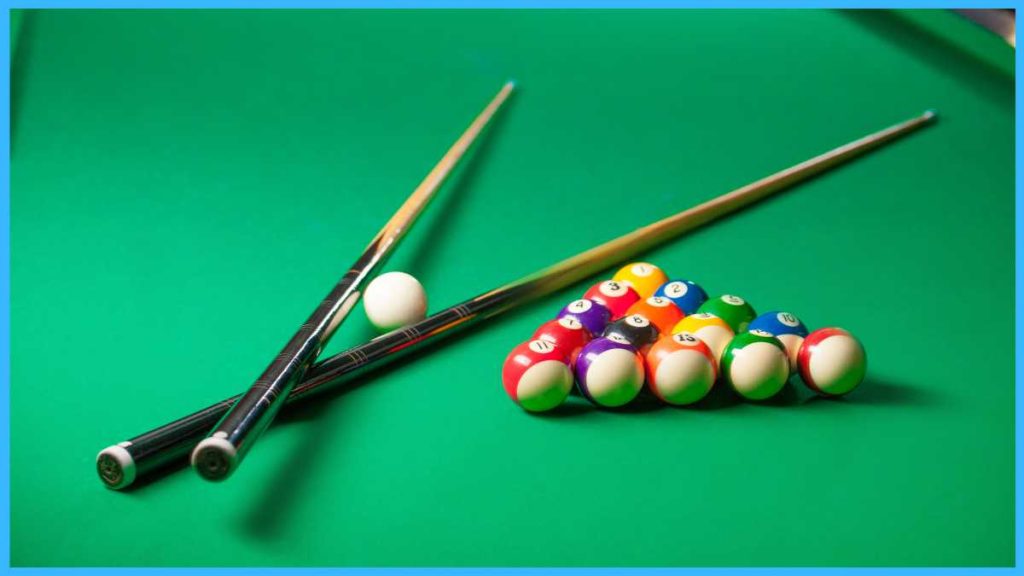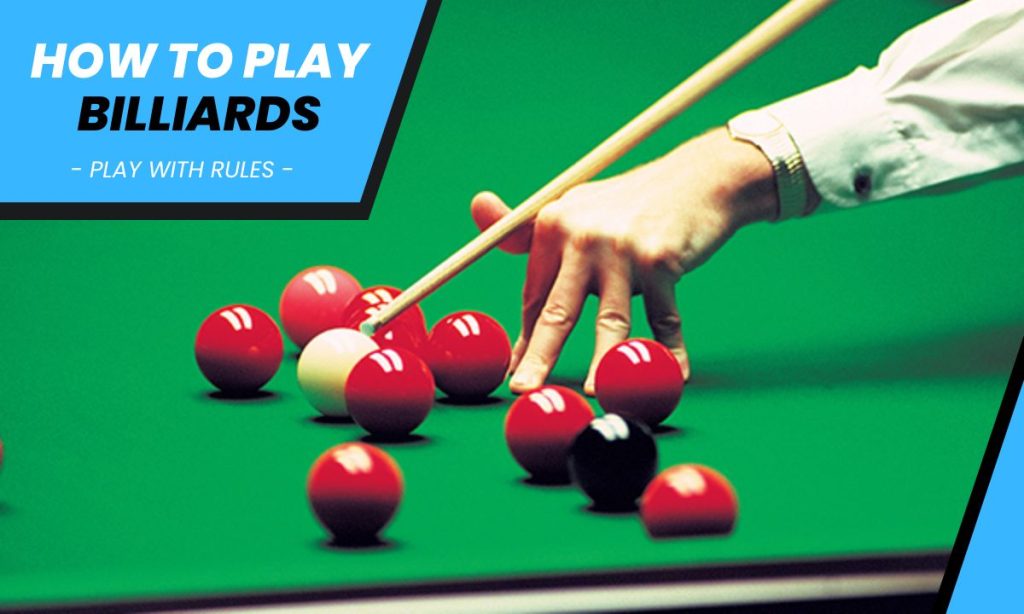While modern-day games are thriving, nothing can beat Billiards. No doubt, the sophistication combined with thrill makes the game more interesting. On top of that, Billiards rules are way too simple that it’s so easy to learn and start playing. But do you know that the game has been around since the early days of the British Empire? A game so old that its roots can be traced back to 15th-century Northern Europe and France when it used to be played as a lawn sport before it became an indoor favorite!
Today, we shall unravel the modern-day version of the game, learn the ropes, and learn a few helpful tips that can come in handy at a billiards table! In billiards, players use a stick, also called a cue stick, to strike their designated balls and drive them into the pockets across the billiards board. However, the shots need to be calculated and strategic to secure better positioning and a higher score than your opponent. Methodically crafted billiards rules need to be adhered to when playing the game. Do you think you are up for it? Then, let’s dive in!
Table of Contents
How To Play Billiards Game?
Billiards, as a concept, has existed for ages. Over the years, it underwent countless modifications before becoming the game that we so dearly love today. In this game, players take turns trying to pocket different-colored cue balls (the color they pick) or score higher than the opponent in one of two ways.
Objective
In billiards, each player aims to score higher than their opponent and first reach the overall score (previously agreed upon). However, scoring comes with its own set of challenges, and one has to be meticulously strategic in one’s thinking and planning. Each move must be backed up with a contingency to prevent the opponent from winning. In short, the objective is to either score higher than your opponent or make it difficult for them to score.
Important Definitions
- Baulk—Baulk is the line drawn across the billiards table on one end, 2 feet 5 inches from the end for six feet, and a one-and-a-half inch table, per billiards rules. This line is called the baulk line, and whenever a ball is within that line, it is said to be ‘in baulk.’
- The “D”—The “D” is actually the semicircle drawn along the ‘baulk’ line (the axis of the D coincides with the ‘baulk’ line).
- Red Ball Starting Point – At the other end of the table from the baulk line and the “D,” a spot is marked that separates the starting point for the red ball. It is marked almost twelve and three-quarter inches from the end cushion.

Billiards Rules
Billiards is a fairly simple game to play, and with the help of different Billiards rules, it is easy to score, break, and more. In this section, we shall break it down so that the next time you want to play the game, you know exactly what to do and what not to do—just like a professional!
Starting The Game
To start, players need to choose the ball that they want to start with. One player chooses the white cue ball, while the other chooses the spotted white cue ball. Then, the following happens:
- Both players place their cue balls within the “D,” and they strike them with their cue sticks down the table. According to the billiards rules, the cue ball must come to rest close to the baulk cushion (edge of the table) after crossing the baulk line.
- The player whose cue ball comes to rest closest to the baulk cushion decides whether to go first or second (usually, the players who win choose to go second because the player who goes first only gets two balls to start with).
- Then, the game starts with the red ball placed on its spot, followed by the player’s cue ball in the “D.”
Basic Play
Once the game has started, both players aim to score higher than their opponents while following the Billiards rules. Each striking turn is referred to as a ‘break.’ In each break, players hit their cue balls using their cue sticks several times until one of the two players either makes a strike with no score or commits a foul. Let’s get familiar with a few more rules of Billiards pertaining to the gameplay:
- Players remain at the table until they fail to make a point-scoring shot.
- As per Billiards rules, after committing a foul, the other player has two options: either have the table left as it is or have all the balls put on the spot.
- After the red ball is potted, it is immediately returned to the red ball spot for the next shot.
- If the cue ball goes ‘in-off’ (explained below), it is then returned to the player, who can position it as they wish within the “D.”
- But if a player pots an opponent’s ball, that ball remains out of play until the ‘break’ ends for that player (plays a non-scoring strike or commits a foul).
- As for the second player (whose ball has been potted), he/she gets to place his cue ball anywhere within the “D” to take his next shot, per Billiards rules.
- If it’s a valid strike, the other player must strike wherever the cue ball ends up.

Scoring In Billiards
The way to win in billiards is to score higher than your opponent. How do you do that? Well, according to the standard billiards rules, there are three ways in which you can score in billiards, and they are as follows:
- In-off (own) – 3 points are awarded for potting a ball or for going in-off the red ball.
- In-off (opponent) – 2 points are awarded for potting or going in-off the opponent’s cue ball.
- Cannon – According to the official Billiards rules, you are awarded 2 points if your cue ball hits both of the other balls (the red ball and the opponent’s cue ball).
Fouls
A good billiards player will always try to minimize his fouls as it reflects poorly on his in-game skills. However, in some situations, a foul isn’t committed on purpose – it just happens. Mentioned below are some situations that can be dubbed as foul, as per the official rules of billiards:
- “Jumping” the ball is disallowed in billiards and will be dubbed as a foul.
- Hitting a ball while still in motion is also considered a foul.
- If you strike your cue ball but it hits no other ball, it’s a foul, and the opponent is awarded a single point per billiards rules.
- If your cue ball ends up in the pocket without hitting any other ball, it is also considered a foul, but in this case, the opponent is awarded 3 points.

Tips & Strategies
Excelling in billiards requires a player to be level-headed. Each shot needs to have a purpose and proper measurement. In fact, if you follow billiards rules properly, then arbitrary shots will most definitely be met with rapid scores from the opponent. So, let’s take a look at a few tips and strategies that might help you get better at billiards:
- Keep your chin vertical to the table and in alignment with the cue ball. This will give you a better understanding of where your shot might end up.
- Don’t hold the cue stick too firmly, as it can lead to a misdirected shot. Wrap your fingers around the brunt of the cue stick lightly, but drive with force from the shoulder.
- Per billiards rules, if you cannot make a shot to pot, make sure you place the cue ball in such a position so that your opponent cannot pot or score higher than you in the next turn.
- Use chalk on your cue stick ends and even around your fingers. This will allow the cue stick to glide smoothly across your fingers, allowing you to strike with precision and power.
- If you are struggling to hold the stick firmly initially, make an ‘okay’ sign with your thumb and index finger and rock the cue stick back and forth within the hold created using the fingers.
- Stand directly behind the cue ball, as this will give you greater force behind your shot.
- When you master the ‘okay’ aiming technique, switch to the ‘V’ groove, which includes making a ‘V’ sign with your thumb and index finger. The thumb carries the weight of the cue stick, and the index finger helps maintain balance.
- Practice hitting the cue ball with the end of the cue stick where you want to hit it. According to rules of billiards, you are usually supposed to hit it squarely in the middle of the belly of the cue ball.
Equipment
To start playing Billiards, you will need the proper equipment. This involves a billiards board with the proper dimensions, three balls, and cue sticks. Let’s learn about these in detail:
- The Billiards Board—According to the rules of billiards, a standard billiards board measures 12 feet by 6 feet and 1.5 inches, with six pockets (4 in each corner and 2 along the middle of the table on either side), each with a connected channel or a net to catch the ball when pocketed. The surface of the table is covered by baize.
- Balls – There are three balls in a billiards game. They are:
- Object Ball (Red)
- White Cue Ball
- Spotted White Cue Ball (sometimes substituted with a yellow ball as well, depending on the Rules Of Billiards and the players’ style).
- Cue Stick – Each player has a cue stick, which can be made of fiberglass or wood. The stick tapers near one end, and that end is used for striking.
- Rests—This is an additional accessory to the cue stick that helps play longer and tougher shots. It’s an extending stick that looks just like the cue stick but has a cross-like structure at the end on which the cue stick is laid when taking aim for a shot. There are two kinds of rests—a full-butt and a half-butt rest. Each of these is longer than usual, comes with an arched fixture at the end, and has its own cue stick.
- Chalk—Chalk is the last piece of crucial equipment used to rub the tip of a cue stick to ensure good and firm contact with the balls when striking. The Billiards rules state that using chalk prevents slipping on contact.

Did You Know?
The history of Billiards is as fascinating as the game. Let’s discover a thing or two about the game now that we are well-versed in the rules and regulations:
- Billiards, also known as English Billiards, originated in England and was initially called the “winning and losing carambole” game.
- The English Billiards Association was the game’s first governing body and was founded in 1885 in the UK.
- The cloth used to cover the surface of a billiard table (baize) resembles grass since sources suggest that Billiards was played as an outdoor sport in the early days.
- English Billiards/ Billiards gave birth to a bunch of other games, such as pool, snooker, and carrom billiards, each with a different set of rules.
FAQs
Are billiards and pool the same game?
No! Billiards is a very different game from pool. In some variations of Pool (for example, 8-ball pool), players are supposed to pot a specific kind of ball (stripes or solids). In Billiards, the game features only three balls. Plus, the Rules Of Billiards are different.
Can you play doubles in Billiards?
Yes. Not a lot of tournaments feature Billiards as a doubles game, but you can obviously play the game as doubles – by taking turns within the team.
Can I play twice in a row?
Depends! If you just potted a ball, then you can. However, if you didn’t then its the opponent’s turn.
Is Billiards an Olympic sport?
No. Billiards is not an Olympic sport yet. However, the International Olympic Committee (IOC) recognized Billiards as an Olympic sports discipline in the early 1990s.
What are the basic rules for billiards?
Billiards is played on a pocketless table with three balls: two cue balls and one object ball. Players score points by hitting both the object ball and the opponent’s cue ball in one shot.
What is the difference between pool and billiards?
Billiards is played on a pocketless table with three balls, focusing on carom shots. Pool is played on a table with six pockets and involves pocketing balls. Billiards tables are larger and use different equipment compared to pool tables.
What are the 8 ball pool rules?
In 8-ball pool, players are assigned solids (1-7) or stripes (9-15). The objective is to pocket all the balls in your group and then the 8-ball to win. Fouls include hitting the wrong ball first, scratching, or pocketing the 8-ball prematurely.
Olympic sport or not, there are a number of Billiards tournaments that are equally thrilling to watch and participate in. Truly a game of sophistication, Billiards combines elegance, masterful skills, tactics, and techniques. Once you get the hang of it, Billiards is a game that you will find to be extremely calming and mind-racking. And now that you know how to play billiards, you can move on to learn about a new sport – a sport that is quite like billiards but has its own set of rules.
Think you know enough? Get, set, and Roll! Keep coming back to Play With Rules for more such impactful learning on sports around the world.

